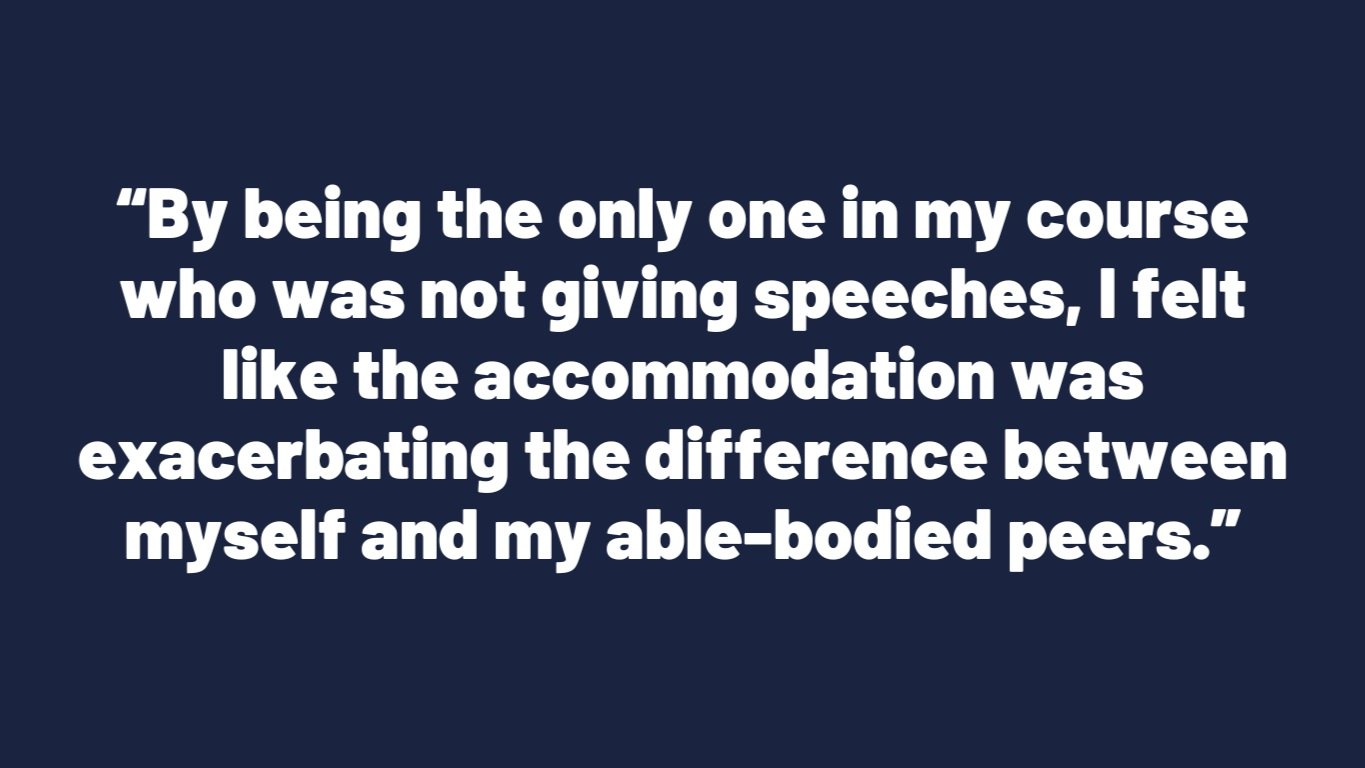Transforming Accommodations in Education by Samuel Dunsiger
Explore Possible amplifies diverse perspectives and lived experiences. The views shared in this post are those of the author and don’t necessarily reflect those of Manitoba Possible.
When I was in my post-graduate marketing program at Seneca College in Toronto, I ended up requesting academic accommodations for a course that involved delivering many presentations due to my speech disability. However, I found the accommodations process to be quite cumbersome.
First, I needed to get a note signed by my speech therapist, effectively proving that I have a speech disability and that I needed accommodations. In other words, I needed to prove to able-bodied school administrators that I have a speech disability. Once I submitted my evidence like I was on trial, I sat down with my instructor to come up with an arrangement, or rather the actual accommodation. We decided that, instead assigning me speeches like my peers would, I would instead edit my classmates’ speeches for course credit.
After a few weeks of this alternative form of assessment, I realized that my accommodations were actually exacerbating my disability. By being the only one in my course who was not giving speeches, I felt like the accommodation was exacerbating the difference between myself and my able-bodied peers.
This occurred in 2009. Since then, I’ve established a career in accessibility justice, supporting students and workers with disabilities — as an Academic Accommodations Advisor at a private university, then as an Accessibility Consultant, and now as a Job Developer. It was an interesting transition going from a student receiving accommodations to being on the other end delivering accommodations to students in need of support.
Having been on both sides of the accommodations process, here are a few things I’ve learned for students, faculty and administrators to keep in mind:
Accommodations are basic human needs, not “special needs”
Historically, accessibility supports and accommodations have been referred to as “special needs” — even today, I see school boards still use this outdated terminology to describe students who have accommodations.
But accommodations are anything but “special needs.” This problematic term feeds the misconception that accommodations are advantages or privileges bestowed onto students, but they are anything but that.
Accommodations are not meant to reduce academic standards or make it easier for students with disabilities. But they are designed to reduce any barriers that students may be facing as a result of their disability and level the playing field for those experiencing barriers. In that sense, accommodations are basic human needs.
Disclosure is not needed to receive accommodations
The fact that I needed to supply documentation before receiving my accommodations at Seneca speaks to the issue of students having to prove their disability before — a process that sometimes involves jumping through hoops — before they can get support. But one thing to highlight is that not everyone is comfortable sharing the details of their disability and that disclosure is always a personal choice. This is precisely why accessibility laws like the Accessibility for Manitobans Act or, in my case, the Accessibility for Ontarians with Disabilities Act exist so that we can get reasonable accommodations without needing to disclose.
Advocating for your needs and for accommodations is vastly different from simply disclosing your disability. For instance, saying “I have ADHD” is different from “I have trouble with getting started on tasks and assignments.” What matters are your needs and the barriers you face as a result of your disability rather than the disability itself.
Accessibility & accommodations are two sides of the same coin
Essentially, accommodations are a reaction to how accessible the learning environment is for students with disabilities. In other words, the more inaccessible a learning environment is, the more individual accommodations are needed.
In my case at Seneca College, for instance, I needed alternative forms of assignments in lieu of oral presentations because of my speech disability. While I worked on the other side of the continuum, alternative assignments emerged as a common accommodation among students I’ve worked with — as people have different communication styles. But instructors need to incorporate this kind of flexibility into their courses to begin with, as opposed to students having to ask for accommodations. What’s stopping instructors from giving students a choice between submitting a paper, delivering a presentation or generating another format altogether? This would likely make the accommodation less necessary.
And that’s precisely my point — instead of having students jump through the hoops and essentially prove their disability to receive accommodations and accessibility supports, we can do more to accommodate students from the beginning.
How? By making courses and learning environments more accessible, so that fewer individual accommodations are needed.
About the Author
Samuel Dunsiger (he/him) is a freelance writer, career advisor and accessibility advocate who identifies as disabled, and works within the intersection of employment and disability. He enjoys using storytelling to normalize living with disability. When not writing or talking shop, he likes to play board games, travel and put together IKEA furniture. He has just migrated from Toronto to Ottawa, where he now lives with his fiancee.

